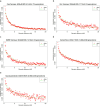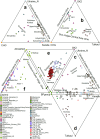This is a preprint.
The Genetic Origin of the Indo-Europeans
- PMID: 38659893
- PMCID: PMC11042377
- DOI: 10.1101/2024.04.17.589597
The Genetic Origin of the Indo-Europeans
Update in
-
The genetic origin of the Indo-Europeans.Nature. 2025 Mar;639(8053):132-142. doi: 10.1038/s41586-024-08531-5. Epub 2025 Feb 5. Nature. 2025. PMID: 39910300 Free PMC article.
Abstract
The Yamnaya archaeological complex appeared around 3300BCE across the steppes north of the Black and Caspian Seas, and by 3000BCE reached its maximal extent from Hungary in the west to Kazakhstan in the east. To localize the ancestral and geographical origins of the Yamnaya among the diverse Eneolithic people that preceded them, we studied ancient DNA data from 428 individuals of which 299 are reported for the first time, demonstrating three previously unknown Eneolithic genetic clines. First, a "Caucasus-Lower Volga" (CLV) Cline suffused with Caucasus hunter-gatherer (CHG) ancestry extended between a Caucasus Neolithic southern end in Neolithic Armenia, and a steppe northern end in Berezhnovka in the Lower Volga. Bidirectional gene flow across the CLV cline created admixed intermediate populations in both the north Caucasus, such as the Maikop people, and on the steppe, such as those at the site of Remontnoye north of the Manych depression. CLV people also helped form two major riverine clines by admixing with distinct groups of European hunter-gatherers. A "Volga Cline" was formed as Lower Volga people mixed with upriver populations that had more Eastern hunter-gatherer (EHG) ancestry, creating genetically hyper-variable populations as at Khvalynsk in the Middle Volga. A "Dnipro Cline" was formed as CLV people bearing both Caucasus Neolithic and Lower Volga ancestry moved west and acquired Ukraine Neolithic hunter-gatherer (UNHG) ancestry to establish the population of the Serednii Stih culture from which the direct ancestors of the Yamnaya themselves were formed around 4000BCE. This population grew rapidly after 3750-3350BCE, precipitating the expansion of people of the Yamnaya culture who totally displaced previous groups on the Volga and further east, while admixing with more sedentary groups in the west. CLV cline people with Lower Volga ancestry contributed four fifths of the ancestry of the Yamnaya, but also, entering Anatolia from the east, contributed at least a tenth of the ancestry of Bronze Age Central Anatolians, where the Hittite language, related to the Indo-European languages spread by the Yamnaya, was spoken. We thus propose that the final unity of the speakers of the "Proto-Indo-Anatolian" ancestral language of both Anatolian and Indo-European languages can be traced to CLV cline people sometime between 4400-4000 BCE.
Conflict of interest statement
Conflict of Interest Statement The authors declare no competing interests.
Figures









References
-
- Anthony D. W. The horse, the wheel, and language : how bronze-age riders from the Eurasian steppes shaped the modern world. (Princeton University Press, 2007).
Publication types
Grants and funding
LinkOut - more resources
Full Text Sources
Research Materials
